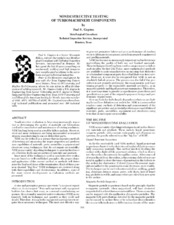| dc.contributor.other | Turbomachinery Symposium (17th : 1988) | |
| dc.creator | Gupton, Paul S. | |
| dc.date.accessioned | 2017-10-05T14:29:03Z | |
| dc.date.available | 2017-10-05T14:29:03Z | |
| dc.date.issued | 1988 | |
| dc.identifier.uri | https://hdl.handle.net/1969.1/163599 | |
| dc.description | Seals | en |
| dc.description | Pg. 161-166 | en |
| dc.description.abstract | Nondestructive evaluation is becoming increasingly important in determining the quality of materials and fabrications used in the manufacture and maintenance of rotating machinery. NDE has long been used as a tool for failure analysis. However, more and more techniques are being incorporated as required steps in manufacturing to ensure defect-free parts. NDE can be defined as a science that incorporates methods of detecting and measuring the major properties and performance capabilities of materials, parts, assemblies, equipment and structures using techniques that do not impair serviceability. NDE uses a variety of probing techniques to assist in the discovery of hidden faults and properties of materials and products. Since most of the techniques used in nondestructive evaluation are based on well-established principles, the proper choice and application of the correct method or methods will determine the final usefulness of the examination. Each of these common classical "Big Five" NDE techniques are reviewed along with their capabilities and shortcomings. In addition, some of the more recent developments in evaluation methods are presented. | en |
| dc.format.medium | Electronic | en |
| dc.format.mimetype | application/pdf | |
| dc.language.iso | en | |
| dc.publisher | Texas A&M University. Turbomachinery Laboratories | |
| dc.relation.ispartof | Proceedings of the 17th Turbomachinery Symposium | en |
| dc.subject.lcsh | Turbomachines | en |
| dc.title | Nondestructive Testing of Turbomachinery Components | en |
| dc.type.genre | Presentation | en |
| dc.type.material | Text | en |
| dc.identifier.doi | https://doi.org/10.21423/R1JQ1V | |


